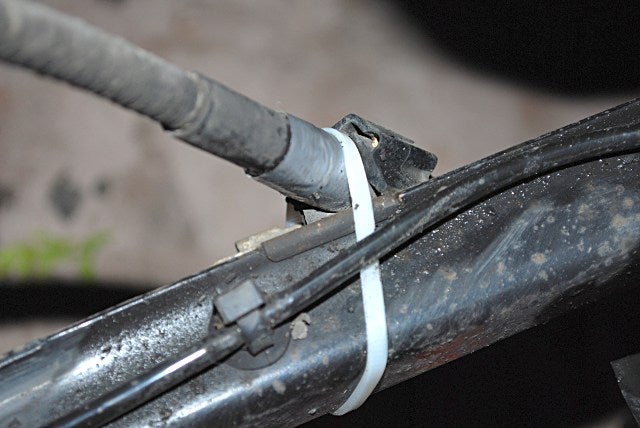Registrations
We now manually approve all new user accounts due to a large influx of spam bots. Accounts are normally approved within 48 hours.
If you need any help with using this Wiki, please ask here: TalkFord.com Wiki Submission Forum
Difference between revisions of "Handbrake Cable Rattle"
52graphite (Talk | contribs) |
52graphite (Talk | contribs) |
||
| Line 20: | Line 20: | ||
[[Category:Mondeo_Mk3]] | [[Category:Mondeo_Mk3]] | ||
| − | [[Category: | + | [[Category:Mondeo_Mechanical]] |
Revision as of 03:35, 13 October 2009
The Mk3 Mondeo is prone to a number of rattles from the rear suspension. These can be from worn subframe bushes, worn drop links, failed anti-roll bar bushes, broken springs and several other root causes.
One of the most common causes, however, is the handbrake cable being loose in its clip onto the rear suspension arm. This is easy to check and virtually free to fix, so ensure this is done on both sides before spending any money.
This picture shows the location of the offending clip (circled in red). The cable should be absolutely rock solid in here: any slight movement can result in a disproportionate amount of noise in the cabin over low-speed bumps.
You do not need to remove the wheel or even raise the car, I've just done so for clarity. If you choose to do so, the usual warnings apply. If you don't know what you're doing, don't do it.
It's easiest to work with the handbrake released, as there's more slack in the cable. Only do this on level ground with the car in gear and securely chocked to prevent it moving.
If your cable is loose, remove the metal clip from the arm by pushing the tab at the bottom inwards, as this gives you more freedom to work. Build up the thickness of the cable at the appropriate point with a suitable tape - I used classic Duck Tape here - so that the cable is now tight in the plastic clip. Try to taper the thickness and wrap the tape such that the exposed edges face in the direction that you'll be pushing the cable back into the clip.
Refit the metal clip to the arm, locating it into the dip in the flange on the top of the arm, then pushing the bottom into the arm until it clicks. For a belt-and-braces approach, apply a cable tie to further reduce movement - put it underneath the ABS wiring as shown, being careful not to put any extra stress on that part.
Close-up of the fixed area:


 Your Privacy Choices
Your Privacy Choices